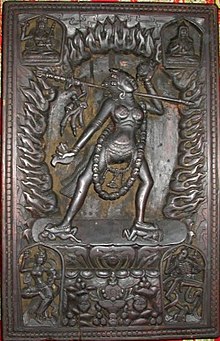ഡാകിനി
തിബത്തൻ വജ്രയാന ബുദ്ധമതം അനുസരിച്ച് ഒരു ദുർദേവതയാണ് ഡാകിനി. തിബത്തിൽ ഖണ്ടോർമ്മ എന്നും അറിയപ്പെടുന്നു. (Mongolian: хандарма; Chinese: 空行母, Pinyin: Kōngxíng Mǔ) ആകാശത്ത് കൂടെ സഞ്ചരിക്കുന്നവൾ എന്നാണ് ആ വാക്കിന്റെ അർത്ഥം . ചൈനയിൽ ഡാകിനി ഒരു വിജ്ഞാന ദേവത ആയും കരുതപ്പെടുന്നു.

മധ്യകാല ഭാരത പുരാണങ്ങളായ ഭാഗവതം,ബ്രഹ്മ പുരാണം,മാർക്കണ്ഡേയ പുരാണം , കഥാസരിത്സാഗരം തുടങ്ങിയവയിൽ നിന്നാണ് ഡാകിനി എന്ന പദം ഉത്ഭവിച്ചത് എന്ന് കരുതപ്പെടുന്നു.പുരാണങ്ങളിൽ പരാമർശിക്കപ്പെട്ട കാളിയിൽ നിന്നാണ് ഡാകിനി എന്ന (Sanskrit: डाकिनी ḍākinī, Pali ḍāginī, Mongolian: дагина) താന്ത്രിക സങ്കൽപം ഉടലെടുക്കുന്നത്.ഡാകിനിയുടെ പുരുഷ രൂപമായി ഡാക എന്ന ദുർദേവതയും പരാമർശിക്കപ്പെട്ടിട്ടുണ്ട്.[1] ഇതുപോലെ പേർഷ്യൻ ഭാഷകളിൽ പരി എന്ന ദേവതയെയും കാണാം. [2]
ദുർമന്ത്രവാദത്തിനു പ്രാധാന്യം ഉള്ള വജ്രയാന ബുദ്ധമത വിഭാഗമായ ജപ്പാനിലെ ഷിൻഗോൺ മത വിശ്വാസപ്രകാരം ഡാകിനിക്ക് ഡാകിനി-തെൻ എന്ന ദൈവിക പരിവേഷം കൂടിയുണ്ട്. ( തെൻ എന്ന സംജ്ഞ ദേവ എന്ന് വ്യാഖ്യാനിക്കപ്പെട്ടിരിക്കുന്നു ) ഡാകിനി ഉത്ഭവത്തെ കുറിച്ച് വ്യക്തമായ തെളിവുകൾ ഇല്ലാ എങ്കിലും പല രാജ്യങ്ങളിലേയും നാടോടിക്കഥകളിലും പുരാണങ്ങളിലും ഡാകിനി എന്ന ദുർദേവതയെ നമുക്ക് കാണാം.
ഖണ്ഡോർമ്മ എന്ന ഡാകിനിയെ വജ്രയാനം(Sanskrit: वज्रयान)എന്ന താന്ത്രിക ബുദ്ധമതത്തിൽ ധർമ്മ സംരക്ഷകയായി പരാമർശിച്ചിട്ടുണ്ട്.[3]

അവലംബം
തിരുത്തുക- ↑ Monier-Williams, A Sanskrit Dictionary 1899
- ↑ David Templeman , Iranian Themes in Tibetan Tantric Culture: The Ḍākinī ed. Blazer, Henk (2002). Religion and Secular Culture in Tibet:. Netherlands: Brill. pp. 113 - p.129. ISBN 90-04-127763.
{{cite book}}:|last=has generic name (help) - ↑ Judith Simmer-Brown points out that "The dakini, in her various guises, serves as each of the Three Roots. She may be a human guru, a vajra master who transmits the Vajrayana teachings to her disciples and joins them in samaya commitments. The wisdom dakini may be a yidam, a meditational deity; female deity yogas such as Vajrayogini are common in Tibetan Buddhism. Or she may be a protector; the wisdom dakinis have special power and responsibility to protect the integrity of oral transmissions" Simmer-Brown, Judith (2002). Dakini's Warm Breath:The Feminine Principle in Tibetan Buddhism. Shambhala Publications Inc. pp. 139–40. ISBN 978-1-57062-920-4.
